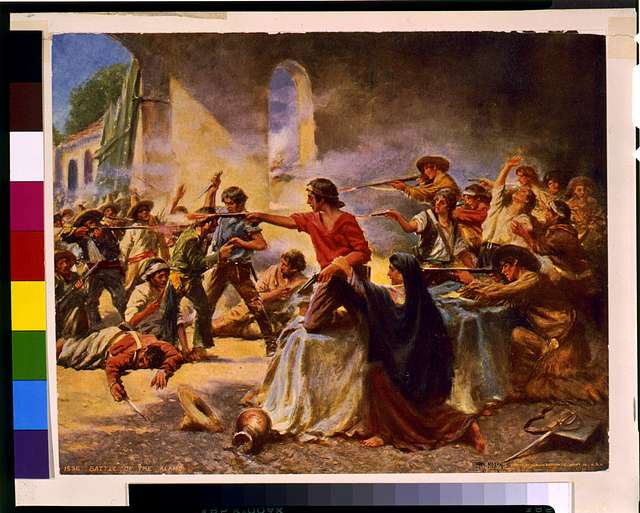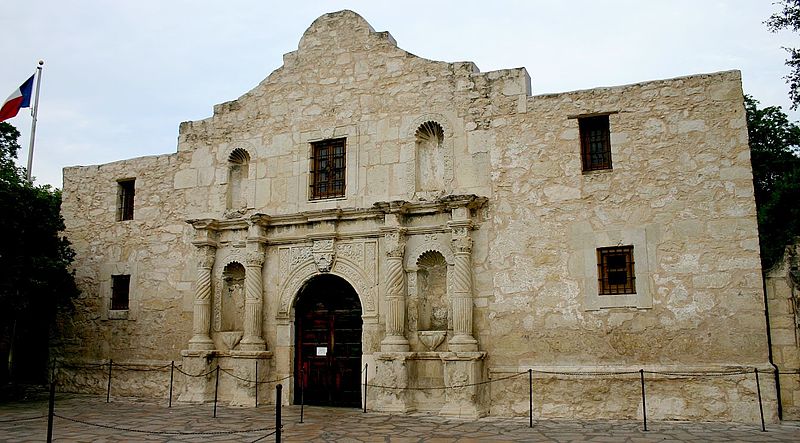The Battle of the Alamo was a pivotal event in the Texas Revolution, lasting for 13 days (February 23-March 6, 1836) in San Antonio, Texas. It ended in a decisive victory for the Mexican forces over the Texan volunteers. Troops under Mexico’s President General Antonio López de Santa Anna reclaimed the Alamo Mission, killing most of the Texians and Tejanos inside. Santa Anna’s cruelty inspired the Texians and Tejanos to join the Texian army for revenge. The Battle of the Alamo symbolized fierce resistance for the people of Texas and a battle cry during the Mexican-American War.
Let’s take a closer look at the historic Battle of the Alamo:
Background
In 1835, there was a drastic shift in Mexico, which owned Texas then. The triumph of conservative forces in the elections unleashed a series of events that caused the drafting of a series of new changes in the constitution that fundamentally changed the organizational structure of Mexico. The changes in the government ended the first federal period and created a unitary republic, officially the Mexican Republic.
Formalized by President Antonio López de Santa Anna on December 1835, they were officially enacted in 1836. The move for change was designed to centralize and strengthen the national government.
The new policies, increased enforcement of immigration laws, and import tariffs caused many immigrants to revolt. The border region of Mexican Texas was populated by immigrants from the United States, and most of them are illegal. These people were used to having a federalist government with extensive individual rights, and they were already vocal in their concerns and complaints against Mexico’s law enforcement and their shift towards centralism.
Mexican authorities are already suspicious of the American immigrants after United States’ previous attempts to acquire Mexican Texas. They blamed much of the Texian unrest on those immigrants, most of whom lived there illegally and made little effort to adapt to the Mexican culture. The American immigrants also continued to have slaves, even when slavery was abolished in Mexico.
In October, Texians engaged Mexican troops in the first battle of the Texas Revolution. Determined to stop the rebellion of immigrants, Santa Anna himself assembled a large force to restore order. Most of his soldiers were raw recruits, and many were enlisted by force.
The Texians systematically defeated the Mexican troops that were already stationed in Texas. The Texian army was dominated by recent regional arrivals, primarily by illegal immigrants from the United States.
Santa Anna was angered by this unrest, thinking it was the United States interfering in Mexican affairs. So, he spearheaded a resolution classifying foreign immigrants found fighting in Texas as pirates. The resolution banned taking prisoners of war, and captured pirates were immediately executed.
When Mexican troops departed San Antonio de Bexar (now San Antonio, Texas), Texian soldiers captured the Mexican garrison at the Alamo Mission. A former Spanish religious outpost converted to a makeshift fort by the recently expelled Mexican Army.
During the Texas Revolution, a string of Texan victories drove the Mexican federal forces south of the Rio Grande by December. However, this success was short-lived – a Mexican army led by General Santa Anna advanced north to put down the rebels, and most of the victorious Texas volunteer rebel army went home. Small garrisons were left in several towns, including San Antonio, where Texans occupied a former Spanish mission called the Alamo. It consisted of three one-story adobe buildings with log palisades that enclosed open plaza areas. Nineteen cannons lined up the walls.
What Happened During the Battle of the Alamo?
In December 1835, a group of Texian volunteers led by George Collinsworth and Benjamin Milam overwhelmed the Mexican garrison at the Alamo and captured the fort, seizing control of San Antonio. By mid-February 1836, Lieutenant Colonel William B. Travis and Colonel James Bowie had taken command of Texan forces in San Antonio.
Though commander-in-chief Sam Houston argued that San Antonio must be abandoned due to insufficient troop numbers, Travis and Bowie dug in nonetheless. Their later reinforcements never numbered more than 200.
The Texian co-commanders, Travis and Bowie, didn’t release warnings that Santa Anna was coming and did little to lay in supplies, food, and ammunition. On February 23, they were surprised when Santa Anna arrived with his advance detachment. He demanded unconditional surrender, but Texians answered it with a cannon shot. Angered, Santa Anna ordered that no quarter be given, and a 13-day siege started.
A Mexican force comprising somewhere between 1,800 to 6,000 besieged the fort. They set up artillery opposite the south and east walls, beginning a steady bombardment with cannonballs being shot back by the Texian defenders until the order came to conserve power. Santa Anna’s troops maneuvered closer to the Alamo but stayed outside the range of the Texian’s rifled muskets.
The cold winter weather made the battle difficult for both sides. On two occasions, a small group of Texian reinforcements broke through the Mexican lines, but many more men joined Santa Anna’s forces. On March 3, the last element of Santa Anna’s army arrived, and he prepared his attack.
Before the dawn on March 6, four columns of Mexican infantry attacked from different directions, and since there were no firing ports at the Alamo, the defenders had to expose themselves so they could fire over the walls. Using cannons loaded with nails, horseshoes, and old iron, the Texians fired into the Mexican forces and repulsed the first assault with rifle fire. The Mexican infantry regrouped and tried again, but they were driven back.
Travis died opposing a mass attack against the north wall that finally penetrated the compound. When a cannon that covered the south was turned around to meet the attack, Mexican troops went over that wall and captured the gun.
When Texian defenders retreated to the barracks buildings for cover, Mexican gunners rolled up the cannon and blew down heavy doors. The troops then rushed in, and room-to-room fighting took place for more than an hour. Bowie died during the battle.
Two groups of Texians who tried to escape were cut down outside the walls by the cavalry, and the last bastion to fall was the chapel, where a small Texian detachment fired their last cannon. Once the Mexican infantry broke through, they fired but were then killed in hand-to-hand fighting.
Texian families that were sheltered there were spared by the Mexicans, but the surviving fighters were executed. Nearly all Texian defenders were killed during the battle. Meanwhile, Mexican forces also suffered heavy casualties, as they lost between 600 to 1,600 men.



